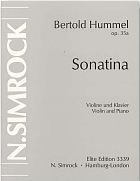Sonatina No. 1 for Violin and Piano op. 35a (1969)
Duration: 6 Minutes
Publisher: N. Simrock Hamburg-London (Boosey & Hawkes) EE 5463 / ISMN 979-0--2211-2255-1
The
Sonatina for Violin and Piano, op. 35a, was written in 1969 and
belongs, along with the Concerto for Percussion, op. 70, to Bertold Hummel's
best-known works. The music has been sold thousands of times all over the world.
Its warm melodies and sparkling rhythms appeal particularly to "the young
player".
It begins with a powerful Maestoso movement. The full
sound of the first theme contrasts charmingly with a lyrical second subject. The
reprise ends with an impulsive Fugato. The second movement, Elegie,
consists of a single melody with great intensity of feeling. The violin soars
sonorously above celestial sounds in the piano. In the virtuoso Finale
vivace, the Sonatina reaches its climax. Passages demanding technical
facility, march rhythms and dramatic climaxes follow each other in rapid succession.
The wild arpeggios of the coda lead to the final close.
The composer, born in Hüfingen, Baden, in 1925, must sometimes suffer for
being identified with a piece that is relatively easy even for young players and
at the same time sounds dazzling; it has attained great popularity and appears
repeatedly at string competitions up and down the country as the pedagogical standard
work of the twentieth century. This Sonatina for Violin and Piano,
op. 35a, from the year 1969 is in fact one striking example from a whole series
of pedagogically motivated works from Hummel's pen, the results of the need to
provide his own children - in total six sons and meanwhile 15 grandchildren -
and the pupils of his wife, Inken, who is today still very much in demand as a
violin teacher, with playable literature which aims to open the way to further
involvement with music of the twentieth century. We teachers of music are thankful
for being able to draw regularly on this great fund of good music.
Michael
Corßen (from "Bertold Hummel und die Sonatine",
Programme leaflet from the Music School, Gütersloh, 2000)
Press
Frankfurter Allgemeine Zeitung, 27th March, 2002
The Sonatina by Bertold Hummel was a breath-taking intermezzo, combining Hungarian sounds and rhythms in a most entertaining way.
Music Teacher, 4th June 1971
This Sonatina in three movements was written for the composer's son and obviously intended to provide something interesting to play befor his technique could cope with all the complications of the seventeenth and eighteenth century classics. The notes are within the compass of the first position, but there are frequent chromatic notes and the use of other positions would enhance the performance. The work ist modern enough with strong rhythmic impulse, the piano part is not difficult and young players would get a feeling of satisfaction in performance.Norah Regan

